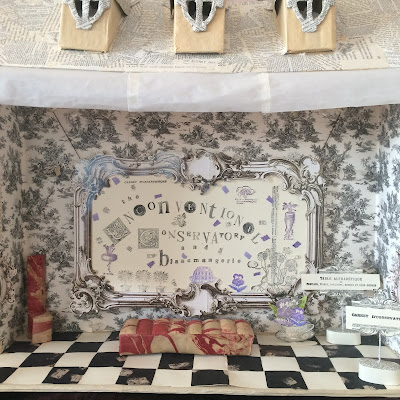I do so hope this finds you all well and safe and staying inside. I know it is such a challenging time for so many of us. And yet, many more of us, who have struggled with health issues feel somewhat oddly prepared for these weeks of staying put inside the house. Even though that is my case, I'm still itching to get outside and get to work on my front porch garden! Before I really get dug into that project (quite literally!), here's a little something that I hope will make your day cheerier.
Today, I'm showing you my newest exhibit at Le Musée Trouvé! The exhibit is called "The Unconventional Conservatory and Blancmangerie" and it turns the museum into a conservatory, filled with some unusual plants, grown in some unconventional ways.
(As always, you may click on the images so you can see them larger.)
I am hoping the bright and fresh colors bring some cheer to your day!
Of course, the museum looks a bit different today, due to the fact that we are not able to accommodate our guests at the present time, but we dream of the day when the museum will be filled with visitors once again. Until then, we are happy to host just YOU today!
It is such a bright and sunny day and it brings such nice light into the museum.
For this exhibit, I rubberstamped images, cut them out and made them into the plants and museum design elements you'll see today. Here's a tiny botanical print I made from stamped images and hung over one of the doors.
Another botanical print, hanging over the other door.
I would like to mention that I know a lot of folks have not been able to find motivation to create things during this time. This is perfectly OK and frankly, just staying safe is enough of a task for any of us. But for me, working on projects helps to keep my anxiety levels down and so I have been focusing on these tiny items to be made each day and have found relief from having to think about other things for a while. It doesn't work for everyone, but it does work for me. I like using the hashtag #MiniaturizeYourFocus when posting on social media. I sometimes think I get so deep in working with tiny things that I don't really have the inclination to think about bigger ones for a whie!
And now, we have arrived at La Chambre des Legumes (The Vegetable Room)!
Here are the rarely-seen varieties of Versailles Lettuce, Hallucination Tomato and Mademoiselle Aubergine Cabbage, all growing quite well here in the museum conservatory, along with one of the glass root vegetable urns.
Did you notice the curtains hanging in the museum today? I made them our of tissue paper and the ornate tassel is another rubberstamped image!
It is quite unusual to get to see the roots of plants while they are growing, but these special, ornate containers allow us to do just that!
Of course, it is always good to grow flowers along with food plants, as they attract bees and other pollinators.
Shown in front, two of the Mrs. Thomasina Thumb Roses, in Violets-in-Dust color, along with the long planter of pansies in Dusk-to-Midnight variety.
Here's another of the Mrs. Thomasina Thumb Roses, in Raspberry Fool color.
There's still more to see, so please follow me to the next room.
This is La Chambre des Fruits!
Several luscious varieties of strawberries and cherries grow here!
The variety of this magnificent cherry is called Monsieur Le Nôtre, named for the French landscape architect and principal gardener of King Louis XIV of France, who designed the park of the Palace at Versailles, as well as collaborated on the design of the parks at Vaux-le-Vicomte, Chantilly, Fountainebleau, Saint Cloud, the Chateau at Saint-Germain-en-Laye and the Tuileries in Paris.
The largest of the strawberries grown here is named Madame Oiseau Rouge. It seems to flourish in the teacup planter.
It only makes sense that the beehive is located along with so many fruits and flowers! We love the bees for all the work they do, pollinating all of the plants.
And now, if you will follow me, we will enter the most special of the rooms in the conservatory...
...The Blancmangerie!
Many people believe that most blancmanges are made in kitchens somewhere, but this is not always true. These are blancmange plants and they come in a wide range of varieties.
They are not always easy to grow and must be grown by very exacting and precise methods. Here we have managed to show you several varieties of them, along with several rare species of the cake plant and a nearly unheard-of (and possibly, unseen) rose variety.
Here we see the Absinthe and Black Forest Blancmanges.
Again, it is important to make certain that flowers are available to entice the bees, although, these rare plants do give off their own particular sweet scents.
Here are the rare cake plants, and under glass, a very rare rose.
This rose is called "The Somnambulist" and at certain times of the day, it turns translucent. It grows best in very protected conditions and so it thrives in this vintage glass display case.
Brambleberry and Strawberry-Pistachio Blancmanges
In an empty room of the museum, we find this angel because, of course, angels can be anywhere.
Stay safe and well, my friends.
Thank you so much for your visit to the museum today.























































